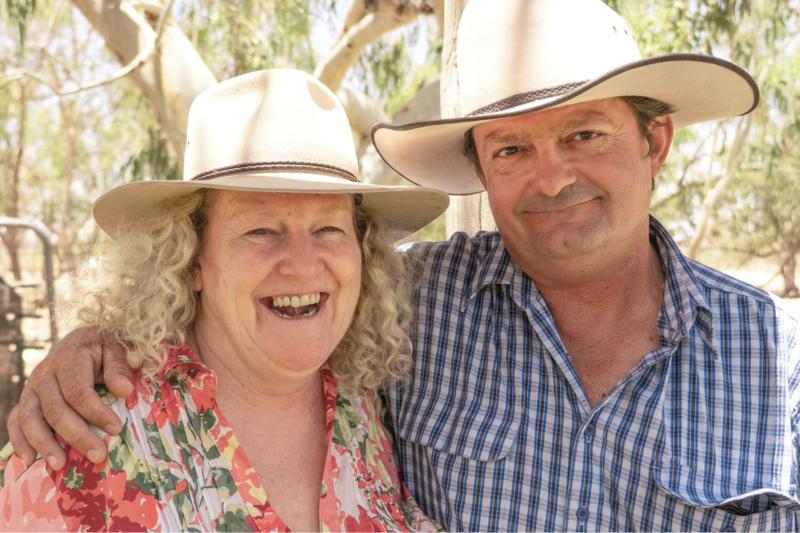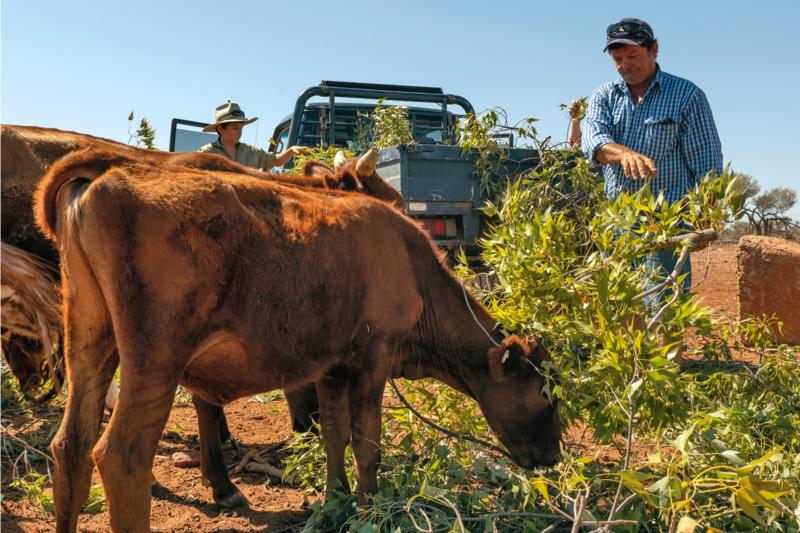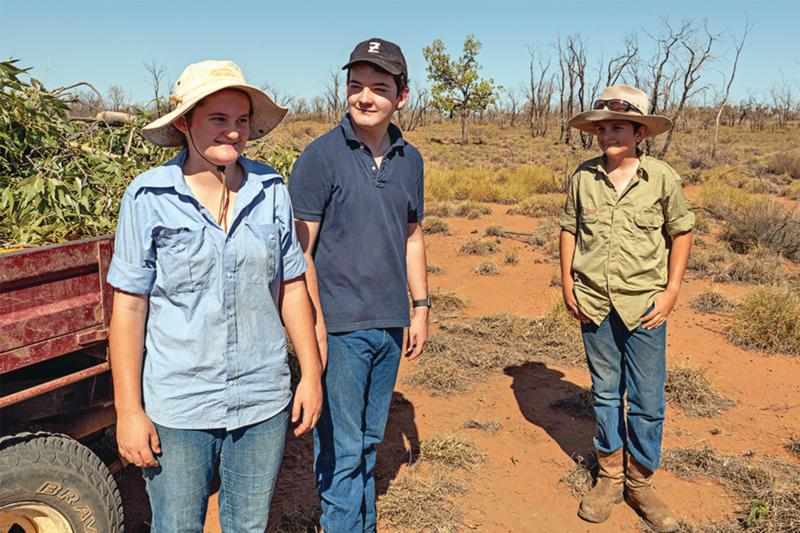Early farming settlers back of Bourke
Nancy Robinson, 73, has lived in the Enngonia area for 50-plus years, rising to the challenges of living on an isolated property and championing community issues.
_preview.jpg) Nancy Robinson, 73, and dog Roc Roc on Ellerslie.
Nancy Robinson, 73, and dog Roc Roc on Ellerslie.
Both my family and my late husband Malcolm Robinson’s family were early settlers in the Bourke area. Malcolm’s great-grandfather Malcolm Robertson bought Ellerslie in 1914.
Originally it was 31,000 acres [12,545 hectares] and the purchase included 31,000 sheep, 33 cattle and 13 horses. That much livestock is hard to imagine. Before this drought, we were running 5,000-to-8,000 sheep, 70-to-80 head of cattle and a few goats here.
Malcolm and I met at Gerara in 1966. He was managing Ellerslie for his grandmother Jean Robinson and I was working on the property next door helping the manager’s wife with her four children. She told me to keep an eye on that Malcolm. Well, I did for 44 years! Within two months we were engaged.
Malcolm was called up for National Service in September 1966. He graduated from the Officer Training Unit and served as a platoon commander with the Pacific Islands Regiment in Papua New Guinea.
It was a huge change for him, from the drought at Ellerslie to the jungles of New Guinea. I got a job with the treasury department at Port Moresby, which was a far cry from mustering sheep and cattle, but for me it was like a luxury paid holiday and I loved it.
Malcolm’s grandmother died in 1968 and later that year, when Malcolm completed his service, he purchased Ellerslie from his grandmother’s estate. In 1983 we bought Glenmore, a mulga and spinifex block, for our drought-proofing policy. During the 1980s, the theory was, you’ve got to get big or get out.
In 1985, we bought the bottom half of Dunsandle for our son Callum who was still away at boarding school. It was 10,000 acres [4,000ha] and had a historic homestead, a cottage, machinery sheds, shearing sheds and huts. In 1990 we added a paddock with its extremely important flowing artesian bore.
_preview.jpg) An aerial view of the homestead at the Robinson’s property, Dunsandle, near Enngonia.
An aerial view of the homestead at the Robinson’s property, Dunsandle, near Enngonia.
You really have to love isolation to survive out here, but we have been involved in a lot of things over the years. I was one of the first women to be chairman of the Graziers’ Association in Enngonia. Malcolm and Callum both served on the Western Division Council for many years and Callum is still on it.
After losing our second son Jamie to leukaemia in 1980, we became big supporters of the first Ronald McDonald House built in Australia. It was established in Camperdown, Sydney in 1981 as a home away from home for families of seriously ill children. The Bourke community contributed more than $10,000 to help the project which was a lot of money then.
Robinsons: the community stalwarts
We are also founding members of the Isolated Children’s and Parents’ Association, which is now a successful national association that enables children living on remote properties to receive an equal standard of education.
RELATED: Preschool filling a gap in rural education
Education is a long-established priority with our family, starting with Malcolm’s great-grandfather, the Reverend Archibald Robinson. He was a Presbyterian minister at Broughshane, Ireland, where he opened three schools with the aim that no child would be doomed to poverty.
_preview.jpg) Nancy’s husband Malcolm’s great-grandfather the Reverend Archibald Robinson and wife Charlotte.
Nancy’s husband Malcolm’s great-grandfather the Reverend Archibald Robinson and wife Charlotte.
Malcolm’s great-uncle Matthew Robinson married [Irish pastoralist and philanthropist] Sir Samuel McCaughey’s niece, Louisa. They lived at Toorale near Bourke and later the Robinson family owned Toorale and Nocheleche and were part-owners of Dunlop. Together the properties totalled three million acres [1.24 million ha]. All were sold in the late 1920s.
_preview.jpg) Four of Reverend Archibald Robinson and wife Charlotte’s 11 children emigrated to Australia – pictured here are Matthew Robinson, Dr William Robinson, the GP at Cobar, Malcolm’s grandfather Guthrie Robinson and Dr Archie Robinson, the GP at Jerilderie.
Four of Reverend Archibald Robinson and wife Charlotte’s 11 children emigrated to Australia – pictured here are Matthew Robinson, Dr William Robinson, the GP at Cobar, Malcolm’s grandfather Guthrie Robinson and Dr Archie Robinson, the GP at Jerilderie.
“Sir Samuel McCaughey donated very generously to schools and hospitals in Australia. He also brought out about 200 families to work on his numerous properties and the descendants of some of those families are my son’s and grandsons’ friends today.”
RELATED FAMILY FARMING ARTICLES:
-
Mixed-farming family makes its mark
-
Farmers swap from sheep to cropping
-
Narooma dairy farmers look to innovation
-
160 years of Booroomooka Beef
My great-grandfather John Laycock was the first person to drive a steam engine from Sydney to Bourke. He came from Yorkshire. His doctor said he needed to move to a dry climate because of his consumption. My gosh, you couldn’t get much drier than this, could you!
So much has changed since then. I’ve also seen many changes, especially in communications. When I was a girl, we had a single wire party phone line.
“My father went from travelling by horse and cart to seeing the Concorde and men land on the moon.”
Now we have smartphones and computers and we save things in the ‘clouds’. It can be challenging keeping up, but I’m lucky to have my grandson Malcolm who is a tech wizard!
Proud Enngonia farmers succeed with sheep, goats and cattle
Callum Robinson, 49, runs goats, sheep and cattle and lives at Dunsandle with his wife Caroline and their three children.
 Caroline and Callum Robinson on Dunsandle.
Caroline and Callum Robinson on Dunsandle.
I grew up at Ellerslie and my wife Caroline and I now have about 69,000 acres [27,900ha] with Ellerslie, Glenmore and Dunsandle. Goats have been our main income for nearly 20 years, but we also have Merino sheep and a herd of cattle.
My father was one of Jean Robinson’s 15 grandchildren and because he had managed Ellerslie for her, he was given the right to buy the property from the rest of them. He always used to say, “Well, I started out with nothing and I still have most of it left.”
Dad passed away in 2010 from cancer. He and I worked this land together for nearly 20 years. He could be stubborn at times. It was the young dog versus the old dog syndrome, but we usually worked things out.
Over the years, we have gone from being wool producers to meat producers. There’s a lot more variety in farm management practices now compared to when we were just running sheep. We use gyrocopters on the farm these days which is something my grandfather was surprised to see, but he loved flying and was one of the earliest flying enthusiasts.
_preview.jpg) Callum's son John, 13, feeds the sheep.
Callum's son John, 13, feeds the sheep.
Out here you’ve got to be resourceful. When a problem arises, you can’t just duck into town and get it fixed. You need to work out ways to get around problems by yourself. If you really get stuck, there’s always someone you can go to who will give you a hand. It’s a small but strong community.
One of the biggest problems we have is finding staff.
“When my parents moved out here in 1968, there were 127 people on the mail run. Now it’s down to nine.”
All these towns used to have their own shearing teams but now there’s only one left in Enngonia and they’re usually away chasing work elsewhere. Most of the time we get a few mates together and get the job done ourselves.
RELATED: Why is there a shortage of shearers?
Next week I’m off to Weilmoringle to give a friend a hand with mustering, then I’ll go to Broken Hill for a border fence maintenance board meeting. I’ll be home for a few days before going off again to give another mate a hand sorting out some sheep on his property.
“In the past 15 years, 12 have had below average rainfall. We’ve downsized and kept our breeding numbers to something we can sustain.”
We are just keeping stock alive really because the dry has gone on so long we can’t afford to purchase much feed. They mostly live on mulga and kurrajong scrub that we cut for them. The tanks are almost dry but thankfully we have flowing artesian bore water, so there’s still water for livestock.
 Cattle at Ellerslie eating kurrajong leaves.
Cattle at Ellerslie eating kurrajong leaves.
Despite all this, I see a positive future for the grazing industry. There’s a new abattoir starting up in Bourke which will bring our freight bill down to next to nothing. Instead of having to go to Charleville with our goats, which costs us about $4.50 per head, we will now be looking at $1 a head. That will make a big difference for us.
Gen-Z all about agricultural technology
Callum's children John, 13, and 15-year-old twins Grace and Malcolm share their experiences of growing up at Dunsandle and look ahead to the future of farming.
 From left: Grace, Malcolm and John on Dunsandle, helping feed the cattle.
John:
From left: Grace, Malcolm and John on Dunsandle, helping feed the cattle.
John: I like the sense of fulfilment I get from doing a hard day’s work on the farm, especially when it involves riding motorbikes. My passion (apart from motorbikes) is looking after animals and knowing that while I’m helping them, I’m also earning my next meal and helping to pay the bills. Honestly, I’m not sure what I want to do when I leave school. I think farming could become a lot easier in the future because of technology but I’m worried that overseas companies will buy us all out.
RELATED ARTICLES ON TECHNOLOGY:
-
Virtual fences to improve labour efficiency
-
Can digital agriculture bring big rewards?
Grace: I have been caring for animals for as long as I can remember. I’ve bottle-fed baby goats, lambs and calves. I’ve given needles and wrapped animals’ wounds with Granny. We have even fixed a few broken legs!
“Not many girls my age can muster on a motorbike, help at shearing, or rescue a sheep that’s been bogged in a tank.”
I feel both positive and worried about farming in the future. Technology could take over and let farmers have a backseat. Some technology is good, but it can’t replace hard work.
Malcolm: I’m into science, maths and technology. When we were doing distance education at home, the technicians came out to install our school computers. Of course, being twins, Grace and I needed to have a computer each. The technicians installed the first one then stopped for morning tea. When they came back, I had wired up the second one by myself. I think living on a farm in the future will be better because of new technologies. Monitoring crops with drones and mustering without having to hire a pilot would make farmers’ jobs easier and more efficient.